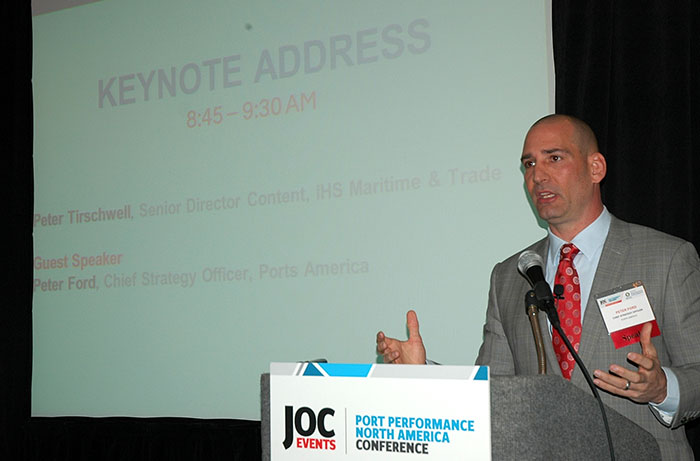Variability is foe of port performance, Ports America executive says
Joseph Bonney, Senior Editor | Dec 08, 2015 10:38AM EST
 Peter Ford, chief strategy officer, Ports America, addresses the JOC’s third annual Port Performance North America Conference in Iselin, New Jersey
Peter Ford, chief strategy officer, Ports America, addresses the JOC’s third annual Port Performance North America Conference in Iselin, New Jersey
ISELIN, New Jersey — Container ports need a fresh, no-holds-barred examination of ways to reduce variability that hobbles productivity, Ports America’s chief strategy officer said Tuesday.
“I think at some point we need to take a white paper and start fresh and work backwards,” said Peter Ford at the JOC’s third annual Port Performance North America Conference in Iselin, New Jersey.
He said ports, particularly in the United States, aren’t keeping pace with demands posed by higher volumes and larger ships. He said the problem is central problem is consistency.
“We have one villain, and his name is variation,” Ford said. He described variation as the opposite of “the ability to get it right every time.”
Ford proposed the creation of an industry-wide group that would seek new ways to reduce variability and improve performance at ports. Such a group would “only focus on the process of conquering variation, and would leave their institutional interests at the door.”
“Assemble a group of industry leaders tasked with redesigning the entire process and all the pieces of information that need to be exchanged, and with whom.” he said. “Designing tomorrow’s process and network should be the only goal. Leave the negotiation of ‘how’ to another day and another set of conversations.”
Taking a fresh look would point the way toward “process excellence” that has eluded many ports, he said. Unpredictability in operations has become more critical as increasingly large ships discharge and load increased volumes of containers.
CMA CGM has said it plans soon to call the Los Angeles-Long Beach port complex with a ship that has capacity of 19,100 twenty-foot-equivalent units, the largest container ship that has called a North America port.
Ford said a ship this size probably would take twice as much time to handle in a U.S. port as in one in Dubai, Europe or China. “Our challenges have been magnified by over 1,200 percent since 1968, if we use the increasing vessel sizes as a measure of complexity, so our approach to these problems has to change.”
No comments:
Post a Comment